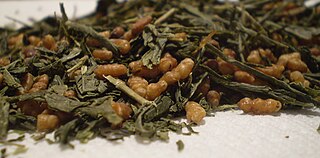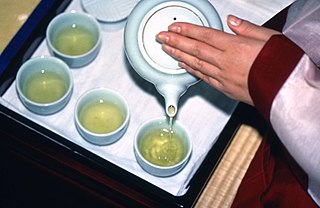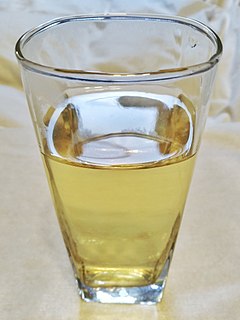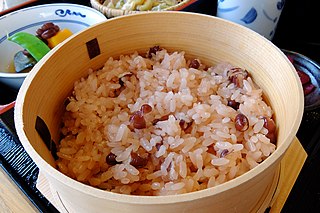| Brown rice tea | |
|---|---|
 | |
| Type | Herbal tea |
| Other names |
|
| Origin | Korea |
| Quick description | Tea made from brown rice |
| Temperature | 100 °C (212 °F) |
| Time | 5 minutes |
| Regional names | |
| Vietnamese name | |
|---|---|
| Vietnamese |
|
| Literal meaning |
|
| Korean name | |
| Hangul | 현미차 |
| Hanja | 玄米茶 |
| Literal meaning | brown rice tea |
| Revised Romanization | hyeonmi-cha |
| McCune–Reischauer | hyŏnmi-ch'a |
Brown rice tea, called hyeonmi-cha (현미차 [hjʌn.mi.tɕʰa] , lit. "brown rice tea") in Korean and nước gạo lứt (lit. "brown rice water"), nước gạo lứt rang (lit. "roasted brown rice water"), or nước gạo rang (lit "roasted rice water") in Vietnamese, is an infusion made from roasted brown rice. [1] [2]
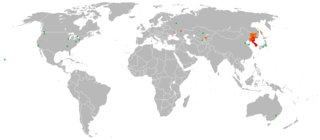
The Korean language is an East Asian language spoken by about 80 million people. It is a member of the Koreanic language family and is the official and national language of both Koreas: North Korea and South Korea, with different standardized official forms used in each territory. It is also one of the two official languages in the Yanbian Korean Autonomous Prefecture and Changbai Korean Autonomous County of Jilin province, China. Historical and modern linguists classify Korean as a language isolate; however, it does have a few extinct relatives, which together with Korean itself and the Jeju language form the Koreanic language family. This implies that Korean is not an isolate, but a member of a micro-family. The idea that Korean belongs to the controversial Altaic language family is discredited in academic research. Korean is agglutinative in its morphology and SOV in its syntax.

Vietnamese is an Austroasiatic language that originated in Vietnam, where it is the national and official language. It is the native language of the Vietnamese (Kinh) people, as well as a first or second language for the many ethnic minorities of Vietnam. As a result of Vietnamese emigration and cultural influence, Vietnamese speakers are found throughout the world, notably in East and Southeast Asia, North America, Australia and Western Europe. Vietnamese has also been officially recognized as a minority language in the Czech Republic.

Brown rice is whole-grain rice with the inedible outer hull removed; white rice is the same grain with the hull, bran layer, and cereal germ removed. Red rice, gold rice, and black rice are all whole rices, but with differently pigmented outer layers.




